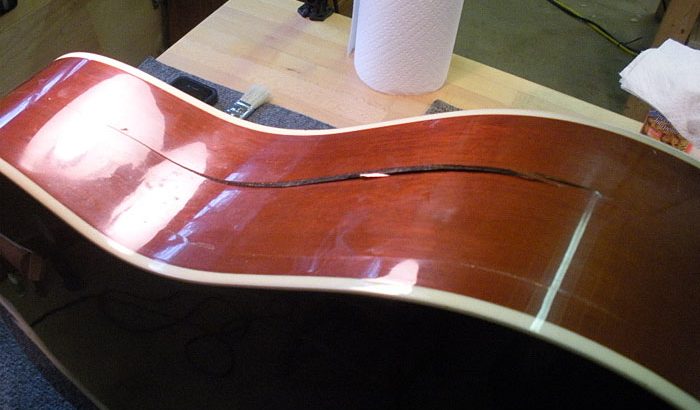The reasons for cracks appearing in acoustic guitars may be twofold. Firstly, due to weather (humidity) changes, and secondly, due to accidents. While the latter you may not always be in a position to control, the former you can almost always prevent.
Humidity related cracks
Here, in North India, as we head into the dry part of summer, I thought that this would be a good time to talk about humidity issues. The drying of your instrument is evident foremost on the top and back and signs generally appear when it is hot and dry and your instrument is not cared for.


A shrinking top or back may even strain the seams and sides of the instrument enough to cause the seam to open or the side to crack.
Tops are built with a degree of arching. As the instrument dries out this arch will flatten and then take on a concave shape.


If you do not humidify the instrument at this point, a crack is well and truly on its way. The same logic applies to the back of the instrument too.
On an instrument that is very dry, an accidental bump to the side can cause a ghastly split along it, not pretty at all.

Even bridges are known to crack more often than not due to lack of humidity, though that is not the only reason for bridges cracking. Badly fitting bridgepins and saddles can also cause a split in the bridge.

So, without a humidity gauge, how do you figure out that your instrument needs a drink? If you feel that that the action on your instrument has got lower (caused by a dry, flatter top), if you suddenly feel the fret ends (due to a shrinking fretboard), or, if suddenly the action has gone too high (caused by a lifting bridge, or the heel end of the neck coming loose),


it’s time to get the humidity up in the instrument, before further corrective steps are taken.
Traditionally, guitar manufacturers used to stick the pickguard directly to the top before the varnish (lacquer) was sprayed on. This keeps the pickguard stuck nice and solid to the top without the pickguard’s corners curling up, as we often see these days. However, this is as much a minus as it is a plus.
When the top wood dries and shrinks, the pickguard stuck to the wood, doesn’t allow it to shrink, causing a split. Did you know that even plastic pickguards shrink? They do – with age, and when they do and if they are stuck directly to the wood of the top, they crack the top, on one or both sides of themselves.
Cracks due to accidents
A knock to the side of your instrument may not seem that bad but if the guitar strings are tuned to pitch the impact may result in a crack. If you’re unlucky instead of that crack you get a split! And that is why you are asked to carry acoustic instruments in (at least) padded cases.

It is not uncommon for guitars to slip out of players’ hands while being carried: again the perfect recipe for a crack to develop, and again, the advice to carry your instrument in cases (preferably hard ones).
Wall brackets are another culprit. If one has not taken care in ‘hanging up’ the guitar, down it comes! Wall brackets are usually safe, provided you keep checking them and the screws that hold them. A loose screw can cause a lot of heartache, not to talk of the damage to the pocket.
Closing cracks
Cracks caused due to (a lack of) humidity are comparatively easy to repair (generally), if they are spotted early. A little bit of extra humidity and most of the ‘opening’ closes. The remaining opening can be closed with glue and some clamping pressure. The only care to be taken here is that the two separated halves align perfectly. Here, cauls – fibre glass or wood – clamped above and below the affected portion, work best in keeping the halves together.
In case of a naughty pickguard, it needs removal. If the crack it caused does not go with humidity, it will need to be glued, often requiring a splinter of wood too. A new pickguard should take the place of the old one.
Cracks as a result of accidents are trickier by nature and almost never in a straight line. The jagged nature of the break calls for a lot of thought, planning and good execution.
Whether caused by humidity or an accident, some cracks may require cleats to reinforce the glued up crack. Cleats are small pieces of wood (preferably of the same material as the wood in the area where the crack is) which are stuck along the seam of the crack so that it does not open up again.

Cracks, if left un-repaired, can often cause more serious issues, especially if it causes the wood to twist out of alignment. If string tension adds to the stress, it should be removed until a repair is made.
Finishing it
One may restore structural stability with a repair one carries out, but finishing the repaired area such that it is near invisible to the eye is the real challenge.
The area of the joint will require to be brought up (in level with the rest of the top, back or side) and my choice for doing that is super thin super glue put in three or four applications after each application has settled and dried, and then wet-sanding the area to level everything.

nice artilce , thank you Admin . keep it up have a great day
Thankyu for this usefull information..